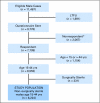Fertility of male survivors of childhood cancer: a report from the Childhood Cancer Survivor Study
- PMID: 19949008
- PMCID: PMC2815721
- DOI: 10.1200/JCO.2009.24.9037
Fertility of male survivors of childhood cancer: a report from the Childhood Cancer Survivor Study
Abstract
Purpose: This study was undertaken to determine the effect of treatment for childhood cancer on male fertility.
Patients and methods: We reviewed the fertility of male Childhood Cancer Survivor Study survivor and sibling cohorts who completed a questionnaire. We abstracted the chemotherapeutic agents administered, the cumulative dose of drug administered for selected drugs, and the doses and volumes of all radiation therapy from medical records. Risk factors for siring a pregnancy were evaluated using Cox proportional hazards models.
Results: The 6,224 survivors age 15 to 44 years who were not surgically sterile were less likely to sire a pregnancy than siblings (hazard ratio [HR], 0.56; 95% CI, -0.49 to 0.63). Among survivors, the HR of siring a pregnancy was decreased by radiation therapy of more than 7.5 Gy to the testes (HR, 0.12; 95% CI, -0.02 to 0.64), higher cumulative alkylating agent dose (AAD) score or treatment with cyclophosphamide (third tertile HR, 0.42; 95% CI, -0.31 to 0.57) or procarbazine (second tertile HR, 0.48; 95% CI, -0.26 to 0.87; third tertile HR, 0.17; 95% CI, -0.07 to 0.41). Compared with siblings, the HR for ever siring a pregnancy for survivors who had an AAD score = 0, a hypothalamic/pituitary radiation dose = 0 Gy, and a testes radiation dose = 0 Gy was 0.91 (95% CI, 0.73 to 1.14; P = .41).
Conclusion: This large study identified risk factors for decreased fertility that may be used for counseling male cancer patients.
Conflict of interest statement
Authors' disclosures of potential conflicts of interest and author contributions are found at the end of this article.
Figures


References
-
- Ries LAG, Melbert D, Krapcho M, et al., editors. Bethesda, MD: National Cancer Institute; 2008. SEER Cancer Statistics Review: 1975-2005.
-
- Oosterhuis BE, Goodwin T, Kiernan M, et al. Concerns about infertility risks among pediatric oncology patients and their parents. Pediatr Blood Cancer. 2008;50:85–89. - PubMed
-
- Zebrack BJ, Casillas J, Nohr L, et al. Fertility issues for young adult survivors of childhood cancer. Psychooncology. 2004;13:689–699. - PubMed
-
- Sklar C. Reproductive physiology and treatment-related loss of sex hormone production. Med Pediatr Oncol. 1999;33:2–8. - PubMed
-
- Sklar CA, Constine LS. Chronic neuroendocrinological sequelae of radiation therapy. Int J Radiat Oncol Biol Phys. 1995;31:1113–1121. - PubMed
Publication types
MeSH terms
Substances
Grants and funding
LinkOut - more resources
Full Text Sources
Medical

